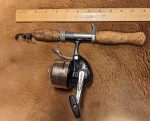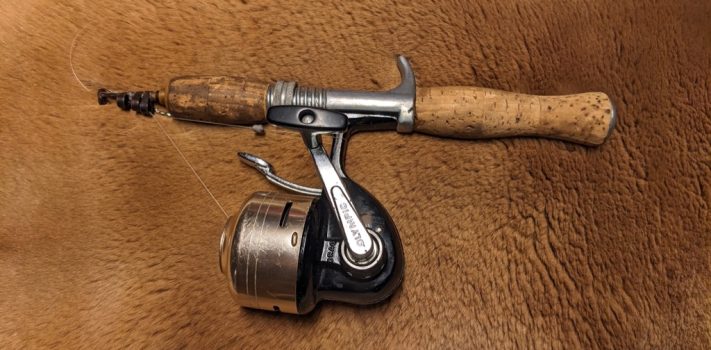From time to time, days of hunger come. Sometimes they come for an individual, sometimes for a family, and sometimes for pretty much everyone at once. Money is short, food is expensive, and it is difficult to keep properly fed. During hungry days, fishing may offer a welcome way to add valuable protein to the daily diet.
Even during days of prosperity, many people find fishing to be a fun and relaxing pursuit. So in good days and in bad, whether providing protein or lowering your blood pressure, fishing may be good for your health.
Some excellent items of fishing equipment are no longer in production. The demands of a consumer society have rendered some top-quality gear no longer economically feasible to produce. The beryllium-copper fishing rod is one example.
The Champion Handle-Rod is a telescoping, beryllium-copper casting rod that was made by the Champion Products Company of Muskegon Heights, Michigan from the late 1940s until the early 1970s. It measures 11 inches when it is collapsed, extends to 5 feet in length, and weighs only 6 ounces. The beryllium-copper alloy used in the rod is as strong as steel, resists taking a set, resists metal fatigue, and exhibits superb corrosion resistance. The compact size into which the Handle-Rod can be collapsed makes it extremely easy to store and transport. The cork handle is very comfortable to grip.
 I have seen vintage examples of these rods come up for sale fairly regularly on eBay for less than $100 including shipping. That is a decent deal from the historical perspective. In 1957, a Champion Handle-Rod cost $13.50 to purchase new. The cumulative rate of inflation from 1957 to 2024 is 995%. That means that $13.50 in 1957 dollars is equivalent to about $150 in 2024 dollars.
I have seen vintage examples of these rods come up for sale fairly regularly on eBay for less than $100 including shipping. That is a decent deal from the historical perspective. In 1957, a Champion Handle-Rod cost $13.50 to purchase new. The cumulative rate of inflation from 1957 to 2024 is 995%. That means that $13.50 in 1957 dollars is equivalent to about $150 in 2024 dollars.
If you need a durable and compact fishing rod for catching moderately sized fish, I highly recommend the Champion Handle-Rod.
Background
Mr. John D. McMillan came home from the army at the end of World War II and founded Champion Products Company. There he manufactured fishing equipment for the next 25 years. The Handle-Rod seems to have dominated the production of the Champion Products Company. It seems likely that the fortunes of the company as a whole were directly tied to the production and sale of this single product. When it was no longer economically feasible to produce and market the Handle-Rod, the Champion Products Company went out of business.
 My experience with the Handle-Rod comes courtesy of my paternal Grandfather. I tend to be a bit on the thrifty side. A less than completely gracious person might easily even go so far as to call me cheap. I would probably never purchase a fishing rod as nice as the Champion Handle-Rod on my own, unless I happened to stumble across it at a garage sale or thrift store for under $10. Otherwise, I would have been content to fish with a second-hand, fiberglass rod.
My experience with the Handle-Rod comes courtesy of my paternal Grandfather. I tend to be a bit on the thrifty side. A less than completely gracious person might easily even go so far as to call me cheap. I would probably never purchase a fishing rod as nice as the Champion Handle-Rod on my own, unless I happened to stumble across it at a garage sale or thrift store for under $10. Otherwise, I would have been content to fish with a second-hand, fiberglass rod.
My paternal Grandfather was just as thrifty as I am, but he practiced his thrift with greater wisdom. My thrift is expressed through the purchase of inexpensive products. Grandpa’s thrift was expressed through buying fewer products, but buying quality in the few products that he did purchase. As a result, he left behind less junk and more treasures to his heirs than I will leave to mine. One of the treasures that Grandpa left behind is a Champion Handle-Rod that ended up coming to me.
 My memories of fishing with Grandpa are shrouded and distorted by the fog of time. I seem to recall a large lake and a small boat. We rowed out to a likely-looking spot and dropped the anchor. I baited my hook and cast my line. As my line hit the water, Grandpa removed the Handle-Rod from his tackle box. He carefully extended it. He unhurriedly attached the reel. He slowly fed the line through the eyelets. With studied patience, he tied on a hook. He leisurely clamped a split-shot sinker to the line above the hook. With great deliberation, he attached a bobber to the line above the split shot. He carefully and precisely baited the hook. And then at long last, he cast his line. It seemed like our fishing time was half over by the time Grandpa got a line in the water.
My memories of fishing with Grandpa are shrouded and distorted by the fog of time. I seem to recall a large lake and a small boat. We rowed out to a likely-looking spot and dropped the anchor. I baited my hook and cast my line. As my line hit the water, Grandpa removed the Handle-Rod from his tackle box. He carefully extended it. He unhurriedly attached the reel. He slowly fed the line through the eyelets. With studied patience, he tied on a hook. He leisurely clamped a split-shot sinker to the line above the hook. With great deliberation, he attached a bobber to the line above the split shot. He carefully and precisely baited the hook. And then at long last, he cast his line. It seemed like our fishing time was half over by the time Grandpa got a line in the water.
Later, I realized that for Grandpa, the purpose of fishing was not to catch as many fish as he possibly could just as fast as he possibly could. The purpose of fishing was to spend time with his grandson. The purpose of fishing was to see the sun in the sky, and to feel the breeze off the water. The purpose of fishing was to enjoy the way the beautiful beryllium-copper sections of the rod slid into place. Grandpa realized that if he caught any fish, he would just have to clean them. What was the rush?
Now that I mostly fish with my own grandchildren, I understand Grandpa a little better. The major reason I fish is to see the look on my grandchildren’s faces when their bobbers disappear under the surface of the water, they set the hook, and they can feel the fish pulsing on the end of the line.
But it is also good to know that if times ever get really tough, I know at least one good way to add a little protein to our diet.
Beryllium-Copper
Beryllium-copper is an alloy of copper that contains between 0.5% and 3% beryllium. It is the strongest of the copper-based alloys, with a strength and hardness that is similar to steel.
During World War II, the United States military used beryllium-copper for the antennae of certain fighter aircraft. One of these aircraft was the Northrop P-61 Black Widow.
Workers at the Northrop plant noted how well the antennae resisted taking a set and how well they resisted metal fatigue. They concluded that the antennae would make excellent fishing rods. They were right, and this use of the material quickly became popular in the post-war period.
The introduction of fiberglass as a fishing rod material quickly undercut the use of beryllium-copper. Fiberglass was much less expensive, and much less hazardous to produce. Beryllium is a carcinogen. In addition to the cancer risk, inhaling beryllium dust or fumes can cause chronic beryllium disease. This illness hinders the transfer of oxygen from the lungs to the bloodstream. Appropriate safety precautions made the production of beryllium-copper even more expensive. (It is important to note that once beryllium has been alloyed with copper, the resulting combination is not hazardous).
After beryllium-copper had been phased out as a material for the production of fishing rods, it became even more popular as a material for the production of golf clubs. Perhaps the average golfer is more wealthy than the average fisherman? In any case, the material eventually became too expensive even for golfers, and is rare in current production clubs.
The Reel
The reel that I use with the Handle-Rod is an old Olympic One-Touch. Like the Champion Handle-Rod, I inherited the One-Touch reel from my Grandfather. The rod and reel did not come together, since Grandpa used the One-Touch with a fiberglass rod and a different reel with the Handle-Rod. I closed the tip of the fiberglass rod that Grandpa used with the One-Touch in the tailgate of a station wagon many years ago. Experiences like that made me to better appreciate the advantages of a telescoping rod like the Handle-Rod.
The One-Touch is a “underspin” or “trigger spin” reel. It is larger than most of the underspin reels currently in production.
I like the balance that an underspin reel gives by hanging below the rod. I like the lower percentage of bird’s-nest-tangles that tend to be produced by closed-face underspin reels versus open-face spinning reels. I am surprised and disappointed that larger underspin reels like the One-Touch did not catch on, and that One-Touch reels are now rare vintage items. I am glad that I have the privilege of owning one.
I have heard that Olympic reels are kind of like the little girl in Henry Wadsworth Longfellow’s poem:
There was a little girl,
Who had a little curl,
Right in the middle of her forehead.
When she was good,
She was very good indeed,
But when she was bad she was horrid.
I am glad that I have one of the very good Olympic reels rather than one of the horrid ones.
Conclusions
I love my Champion Handle-Rod. It is compact, light, and easily portable. It is durable, attractive, and corrosion-resistant. I had a chance several months ago to buy two of them on eBay for a total of $65 plus $10 shipping if I remember right. I decided to wait for a better offer. I now bitterly regret that foolish decision.
I also love my Olympic One-Touch spinning reel. I like the way it enhances the balance of the rod by hanging below the rod, and the way it handles line so well with a closed face. I probably won’t buy any additional Olympic reels though, because of their mixed reputation for quality.
If you have a favorite rod or reel, please drop Senior Editor JWR or Avalanche Lily a line for the snippets column to tell about it. Their addresses are jamesATrawles.to and lilyATsurvivalblog.com. Or if you would rather tell me, you can reach me at ThomasKChristiansonATgmail.com. (In all of those, change the “AT” to the @ symbol.)
Disclaimer
I did not receive any other financial or other inducement to mention any vendor, product, or service in this article.










